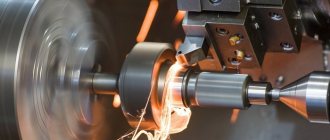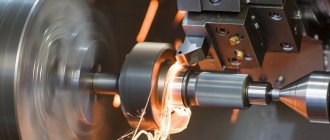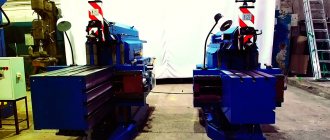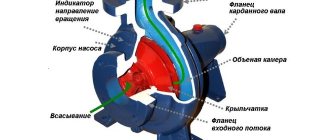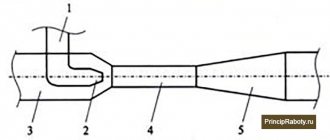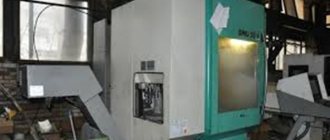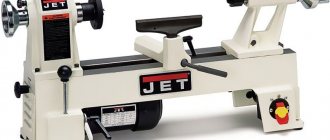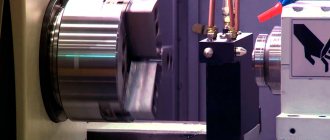CNC lathes are well-proven equipment designed for mass production. Thanks to it, it becomes possible to make parts with high precision, which is important for lathes.
CNC allows it to improve its operation without human intervention, making it almost ideal for turning work and giving it autonomy.
Purpose of the CNC device
Numerical control (CNC) is designed for cutting threads on workpieces, turning parts from them, etc., without human intervention to avoid defects in production.
Thanks to fairly flexible settings, they have proven themselves much better than humans, and due to the fact that they have minimal defects, machines equipped with such a system are simply irreplaceable in mass production, where it is important to produce many parts that meet the quality. There are also types of turning work that only numerical control can handle.
If we divide CNC machines into types, then we need to take into account the purpose and the work they perform. In this case, they can be divided into five types:
- vertical and horizontal milling;
- console;
- longitudinal;
- widely versatile;
- instrumental.
Main advantages
Compared to manual machines, those equipped with CNC are four times more productive. Although the performance range varies from the specified settings and can be from one and a half to five times.
Due to the fact that a CNC machine combines the flexibility of universal equipment and the high productivity of an automatic machine, the problem of using such technology in both serial and individual production is solved.
Important!
Thanks to the latest electronics and the best computer technology, mechanical engineering, namely the production of parts for automobiles, is reaching a predominantly new level.
Due to the fact that the process is becoming almost completely automated, the need for qualified workers to operate the machines is falling. However, this cannot lead to unemployment, since craftsmen are now required who will monitor the serviceability of the CNC machine. Thanks to this, the quality of work improves without consequences.
The time required for fitting work is significantly saved due to the fact that the parts are made, one might say, according to one template, so they are interchangeable.
Due to the fact that all programs for the production of new products are recorded in the computer, there is no need to retrain personnel before switching to working with new products. You just need to turn on the desired program.
Parts that are made on a CNC machine are produced much faster. In addition, due to the absence of a person, the level of defects and unfinished work is significantly reduced.
Programming
The CNC machine starts in automatic or semi-automatic mode only if there are numerical control programs (NC). It includes all the actions and principles by which a four-axis machine tool will operate. When creating a control program, the following are specified:
- number of transitions and passages;
- parameters of the workpiece being processed;
- main characteristics of the working tool.
The NC is created on a computer using special applications for working with machine tools. We learn to work on programs:
- AutoCAD;
- T-FlexCAD;
- SolidWorks.
Using the listed software, three-dimensional examples are created, on the basis of which real parts are manufactured. After this, it is indicated what kind of work will be carried out to implement the task. If you learn how to create control programs, it will be easier to work with machine tools.
What metal operations can be performed
Thanks to the fact that the human factor has been reduced to a minimum, metal operations have become much easier and result in less waste. It turns out this way because of the program that is embedded in the computer.
It is a kind of template by which the computer understands whether the part is ready or not. This section will talk about the operations that a CNC machine can perform on metal.
External and internal turning of parts
Everything is simple here, at least for the car. The installed workpiece, which in the future will become a part, is fixed on the machine. It can be secured manually or, if the appropriate equipment is installed automatically (most often the automatic option is used).
Afterwards, external turning of the part begins using either a laser or a blade that is installed on the machine. Gradually cutting off the excess, the workpiece takes the shape of the desired part. This is how external turning of parts is done on a CNC machine.
With the internal everything is about the same, only with changes. After installing the workpiece, the machine begins to drill, or as it is called differently, drill a hole at the base of the workpiece.
Once the hole is ready, the computer will compare it with the template that is written in the given program. If there are any flaws, he will analyze whether it can be corrected (as a rule, yes, because machines rarely make mistakes). Afterwards the workpiece is polished and the part is ready.
Longitudinal processing of the workpiece
Longitudinal processing is a method that is used for the manufacture of strips, strips, tapes. Depending on the program that is installed on the computer.
Such work on a CNC machine is carried out mainly using a laser, as this allows you to get rid of defects and speeds up the work process. After installing the workpiece, the numerical control on the machine will process it in accordance with the specified algorithm of actions. The laser portal is driven by stepper motors on which it is mounted.
Roughing and finishing
To begin with, what is this anyway? Roughing of metal consists of adjusting the part to the desired size by removing layers of metal.
Typically, in a CNC machine, this role is performed by the computer after the part has already been cut. Finishing comes next and consists of polishing the surface of the product. The machine performs all this according to given algorithms.
Adjusting the length of parts
The program that is given to the computer clearly states the dimensions of the part. The blanks are also given in suitable sizes. Before inserting a part, the machine adjusts and sets itself up for production.
After that, he begins to do the work, after which he compares the size with those given by the person. If there are no deviations, the part is ready. If there is, the CNC machine begins to grind the part, removing layers of metal and adjusting the length.
Making grooves, recesses and holes
Grooves and recesses are holes that are made into a part. Such holes can serve either to allow another part to fit into them, or for installation to some device. A CNC machine makes such holes using a laser, making high-precision cuts.
They can be rectangular, T-shaped, dovetail, shaped, through, open, closed and others. What shape the hole will be depends on the part and the program that the person has installed in the numerical control.
Inch and metric thread cutting
Almost everyone has seen this type of carving. It is used mainly so that one part can be screwed to another. The main parameters in the manufacture of such threads are pitch and size. In this case, a step means:
- outer diameter, measured between the top points of the threaded ridges located on opposite sides of the pipe;
- internal diameter as a value characterizing the distance from one lowest point of the cavity between the threaded ridges to another, also located on opposite sides of the pipe.
All parameters need to be entered into the machine’s computer, after which it will cut out an excellent and even thread using a laser.
Reference! In any case, the parameters for making threads on a product are entered by a person into the computer of the machine, and the latter, acting according to an algorithm, uses a laser to make an excellent thread.
Accessories
The set of components for CNC equipment directly depends on its type. However, there are details common to the fundamental design of such machines:
- Bed - depending on the overall dimensions of the equipment, it can be either floor-mounted or table-top;
- A portal is a set of guides along which the working part moves in a two- or three-dimensional coordinate axis;
- Power units are servos that drive the portal, as well as an electric motor that transmits rotational motion to the spindle;
- Various mechanical parts: rail guides, shafts, bearings, couplings, etc.;
- Control controller - a communication board on which the program is recorded, and sensors that control the operation of the device;
- Power supplies.
Design and principle of operation
Lathes equipped with a CPU are of three types - contour, positional and adaptive. Each has its own advantages and may be suitable for different types of work.
The first type of machine cannot be called maximally independent, since human intervention is necessary for its operation. It works only along the trajectory specified by the operator.
The second type of machine can perform work on a part in a point-by-point manner.
The third type is universal. It can perform the work of both machines, while having the same functionality, so this type is the most expensive and most useful in the production of various parts.
Compared with older analogues that are already outdated, the latest machines with an installed numerical control system have increased rigidity, which allows reducing production time even for quite complex types of work. This level is ensured by the design features of the machines.
The CNC lathe consists of:
- beds;
- spindle or headstock;
- calipers;
- feed boxes;
- electrical part;
- turret heads.
The bed is one of the main parts of any machine, since it is on it that all other parts of the machine are located. The spindle (or headstock) has two parts of the machine: the spindle itself and boxes for changing speeds on the machine.
Another important part is the caliper. It is he who regulates the rotation speed of the workpiece, which is fixed in the lower and upper carriages. The caliper is controlled using one of the spindle parts, namely the gearbox.
Turrets are also very important for the operation of the machine, as they automatically replace worn-out equipment. The workpiece is installed in the machine, and then it does the work itself, using a program pre-written by the operator.
Main components of a CNC machine
A CNC machine consists of the following key components:
- data input devices;
- BUS (machine control unit);
- actuator;
- drive systems;
- feedback systems;
- control panel.
The object processing program is loaded into the machine through the data input device.
Input devices are usually magnetic tape readers, punched tape readers, and computers operating via an RS-232-C port.
The BUS controls the unit, performing the following operations:
- reads and decrypts code instructions entered into it;
- Performs circular, linear and spiral interpolation to generate axis motion commands;
- transmits axis movement commands to the amplifier circuits to control the axis mechanisms;
- receives feedback regarding the positions and speeds of all drive axes;
- turns coolers or spindles on and off, changes tools, and performs other auxiliary functions.
CNC machines typically have movable tables and spindles that control speeds and positions. The actuators control the spindles in the Z-axis direction and the tables in the X- and Y-axis directions.
Drive systems include amplifier circuits, drive motors, and ball screw bearings (ball screws). The BUS sends signals about the speed and position of each axis to the amplifier circuits. These signals are then amplified to drive the drive motors. These motors rotate the ball screw to adjust the desired position of the work table.
The feedback system (also known as the measurement system) has built-in sensors, also known as transducers. They constantly monitor the speed and position of the cutting tools. Signals from the sensors are sent to the BUS, where the difference between the original signals and feedback signals is used to generate the next series of signals.
The operator can move the control panel to a convenient position. The display will show commands, programs and other necessary information.
How to write a control program
Programs for operating CNC machines are made in three steps, each of which determines what the new part will look like:
- Creation of a three-dimensional model. This stage is the creation of a model of the workpiece with which the work will be carried out. This is mainly done not by operators, but by designers, since not everyone understands so well how to make a good three-dimensional model.
- Instructions. Having a three-dimensional model, the operator sets the parameters that the machine will have to perform when working with the workpiece in order to get the part.
- Test run. It is necessary to check whether the program was written correctly to work. After all, if you run a bad program on a machine right away, without a test, it will ruin all the workpieces. Therefore, the operator looks to see whether the machine is performing the job correctly with the given program, and then looks at the result and decides whether modification is required or not. Most often it is, of course, required, but it cannot display any critical errors.
Once the program has been installed, the machine is ready for use. There are five special applications for writing such programs:
- AutoCAD.
- T-FlexCAD.
- NanoCAD.
- ArtCam.
- SolidWorks.
Now we will talk about each one separately.
AutoCAD
This program was developed by Autodesk specifically for automatic design of turning operations. AutoCAD has 3D modeling functions, as well as the ability to work with 3D scan data, which allows you to save money on designers. But, due to the lack of three-dimensional parameterization, this program is not the best choice.
T-FlexCAD
This program was developed to develop different types of work with lathes. It has all the necessary functions, but it is not the best choice and is not popular.
NanoCAD
This program can work with both three-dimensional and two-dimensional models. With its help, work calculations can be carried out, 3D and 2D models, various drawings and much more can be prepared. Thanks to this program, the work of operators is greatly facilitated.
ArtCam
This program is needed exclusively for creating a three-dimensional model. Calculations of work or anything similar cannot be done on it, but the models are of very high quality.
SolidWorks
This is not just a program, but a whole software complex. It was released back in 1995, but is still considered one of the best among the development of programs for lathes using a CNC system. True, this software package costs a decent amount, but it perfectly demonstrates the principle “price equals quality.”
Features of numerically controlled machines
The first unique characteristic is the high importance of computer-aided design. At this level, the main activity of the engineer is carried out, then he can only check the correct execution of commands and transfer all subsequent work to adjusters and operation specialists. Digitization of the graphic model into a programming language supported by the CNC system occurs automatically. The two main actions of specialists are adjustment (readjustment) of equipment and supervision of the operation of the machine.
Varieties
There are enough varieties of lathes to perform a wide variety of jobs. There are five of them in total:
- horizontal turning-turret;
- tokor-frontal;
- rotary turning;
- multi-spindle;
- turning and milling.
Now we will talk about everyone separately.
Horizontal turning-turret
Designed mainly for mass production of parts. Using a chuck, parts are installed that will process the workpiece before it becomes a part.
Torque-frontal
This machine is used for processing parts whose diameter exceeds the size of the workpiece. These are mainly railway wheels, flywheels and others. It can also remove ends, make cylindrical parts, make grooves, and so on.
Lathe-rotary
Such machines are designed for workpieces that weigh several tons. Also, the workpieces for such a machine have a diameter greater than their height. Thanks to the chuck and the cutting parts installed on it, it is possible to apply threads to the workpiece or drill holes.
Multi-spindle
As the name implies, the design of this machine contains several spindles, which ensure processing of the workpiece to the state of the part in several places, either simultaneously or in shifts after every certain period of time.
Turning and milling
Turning and milling machines with installed CNC are universal. They can perform a wide variety of work with products. Everything will depend on what program was installed in the numerical control computer and what tools were installed on the chucks.
This machine can perform any functions of highly specialized equipment, be it turning, drilling, milling. He can handle any type of work.
What can be programmed in production
You can program anything that has a CNC unit - even a woodworking machine, a laser cutting machine, or a spot welding manipulator. The main thing is that the necessary parts of the production unit are equipped with drives and sensors.
A drive is something that makes something move. For example, to make a robotic arm, you need 5–6 drives that will drive the joints of the robotic arm. You can tell the actuator, “Accelerate this many degrees,” or “Turn this much,” and it will set in motion whatever is attached to it.
A sensor is a thing that collects some data. For example, rotation speed, temperature, pressure, bend angle. Thanks to the sensors, you can say: “unbend the drive such and such until you feel such and such a pressure force with the pressure sensor.”
Review of modern models of CNC turning machines
Compared to older models, modern lathes have become easier to use and can perform many more functions. The operation of such machines has become faster and better, providing better quality and fewer defective products.
Thus, we can say that CNC lathes are the future. Thanks to him, the number of defects due to human defects has become almost zero, despite the fact that no one has lost their jobs - it’s just that now the specialists who previously worked on the machines now monitor the operation of these machines, correcting breakdowns and giving them new programs.
What knowledge do you need to have to work with a CNC machine?
To successfully work on a CNC machine, you must be able to perform the following operations:
- create models of parts in graphic editors;
- install programs in the unit’s RAM;
- set optimal modes and control parameters for microstepping motors.
As work progresses, it will be necessary to visually monitor all technological operations through a panel that displays all current information in real time.
The most common software control systems today are Linux CNC, USB CNC, Mach3, OSAI, Fanuc, Rich Auto, OSP, Sinumerik, Heidenhain. All of them are more or less the same type, and only Heidenhain differs noticeably from the others in its management.

